Dark, mysterious and noble creatures, owls have been both revered and feared throughout history dating as far back as the earliest civilizations. The ancient Egyptian name for owl translates to ‘the one who laments’, which evokes sadness and death. And yet, in ancient Egypt, owls were given the hieroglyphic symbol for the letter “M” and were honored through sculpture and mummification. Owls are an ancient bird, showing up in the fossil record more than 40 million years ago, which has given humans plenty of time to contemplate their presence.
The Romans feared owls, believing that they were harbingers of death, while the Greeks saw them as great protectors, with the owl depicted as the sacred mascot of Athena, the Greek goddess of wisdom, war and the arts. In Japan, pictures and figures of owls were used to ward off famine, and, in some parts of Northern England, the image of the wise old owl dates back to the time of King Arthur and the Welsh prophet and sorcerer, Merlin, who was always depicted with an owl on his shoulder.
Perhaps no other bird inspires as much fascination, awe, and fear. Owls are different than other birds of prey (raptors). Like all raptors, they have sharp talons and hooked beaks. But owls also have large heads, with a more round facial disc and eyes that face forward, like humans do, with an unblinking stare that both mesmerizes and appears all-seeing. And while not all owls are nocturnal, owls are seen as birds of the night, operating in realms that most humans find dangerous and threatening. Perhaps this is why owls have been both feared and admired in myth and legend in cultures around the world.
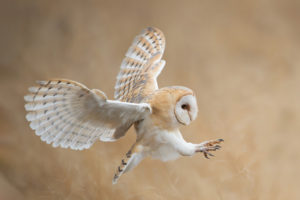 Silent on the wing, gliding like ghosts through the forest or flying low over the ground, owls are deadly accurate hunters with unique adaptations that allow them to function as top predators. Owls are such accurate and efficient hunters that homeowners in some parts of the country are constructing barn owl boxes to help eradicate rodents and pests—studies have shown that an average Barn Owl family eats 1,300 rats per year and 3,000 rodents during breeding season.
Silent on the wing, gliding like ghosts through the forest or flying low over the ground, owls are deadly accurate hunters with unique adaptations that allow them to function as top predators. Owls are such accurate and efficient hunters that homeowners in some parts of the country are constructing barn owl boxes to help eradicate rodents and pests—studies have shown that an average Barn Owl family eats 1,300 rats per year and 3,000 rodents during breeding season.
One of the reasons owls are such effective predators is because they are nearly silent fliers. Owls have both a soft hairline fringe along their rear wings and a stiff fringe on the outer edges of their forward wing feathers (called fimbriae), which help soften the flow of air as it moves over the wing. Their flight feathers are also dense and velvety soft, absorbing almost all noise and dampening any sound of air turbulence over the wing. This allows owls to fly almost soundlessly through the air—at speeds up to 40 miles per hour, as in the case of the Great Horned Owl.

Photo Kurt Lindsay
The flattened facial disc of owls is another unique adaptation particular to owls. It funnels sound to the ears, magnifying it as much as 10 times that of normal sound, which allows owls like the Great Gray Owl to hear a mouse squeaking at a distance of half a mile away or up to 18 inches under the snow. Many owl species also have asymmetrical ears that are at different heights on their heads (and often different sizes), allowing them to detect the exact location of prey due to a small difference in time when the sound reaches the ear. In fact, studies with barn owls conducted in total darkness have shown that they are capable of catching mice by hearing alone.
Once located, prey are rarely missed by the sharp talons and unique, flexible feet of owls. Owls have zygodactyl feet with two toes pointing forward and two toes pointing backward (a trait typically only seen in arboreal species that climb tree trunks, such as woodpeckers, cuckoos and parrots). However, owls have a unique adaptation that allows them to pivot one of their back toes forward, giving them a powerful and crushing grip that enables them to be highly effective predators.
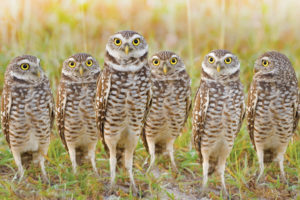 Owls can be found on every continent except Antarctica. There are about 250 species of owls in the world and 14 species can be found in Idaho.
Owls can be found on every continent except Antarctica. There are about 250 species of owls in the world and 14 species can be found in Idaho.
Not all owls are nocturnal (active at night). Some are either diurnal (active during the day, such as the Northern Pygmy Owl) or crepuscular (hunting primarily during dawn and dusk, such as the Great Grey Owl).
Many owls vocalize at a distinctively low frequency, which allows their songs to travel long distances without being absorbed by vegetation, and not all owls hoot (only the Great Horned Owl makes that distinctive “hoo hoo” sound). In fact, owls can make a wide range of other sounds, such as screeches, whistles, chirps, shrieks, rattles, hisses, barks, growls, and warbles.
Owls tend to form strong bonded pairs and are generally monogamous; and several species, such as the elusive Barn Owl, mate for life. Many species also use a special type of call or hoot to communicate between mated pairs and owl pairs will often perform duets together to reaffirm their bond—which is a pretty romantic gesture for a bird that has been both feared and worshipped as a fearsome symbol of the night.
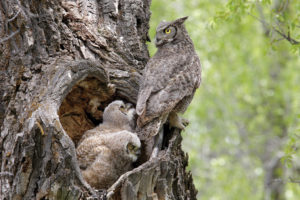
[Audubon Owl Facts]
• The eyes of an owl are not true “eyeballs.” Their tube-shaped eyes are completely immobile, providing binocular vision which fully focuses on their prey and boosts depth perception.
• Owls can rotate their necks 270 degrees (this compensates for having fixed eyes—they can’t really turn their heads all the way around, it just looks that way!)
• A group of owls is called a parliament. This originates from C.S. Lewis’ description of a meeting of owls in The Chronicles of Narnia.
• Owls are opportunistic nesters—they don’t build nests and often take over the abandoned nests, hollows or crags of other birds or animals.
• The tiniest owl in the world is the Elf Owl, which is 5-6 inches tall and weighs about 1.5 ounces. The largest North American owl, in appearance, is the Great Gray Owl, which is up to 32 inches tall.
• Many owls have feathered legs and feet for warmth.
• The “ear tufts” visible on some owl species are not ears at all, but display feathers used in defensive postures. Owl ears are actually located on the side of the head, behind the eyes, and are covered by the feathers of the facial disc.
• Owls are farsighted, which means that they can’t see things close to their eyes clearly. Up close, everything is blurry in the sight of owls, and they depend on small, hair-like feathers on their beaks and feet to feel their food.
 Barn Owl
Barn Owl
Tyto alba
A medium-sized white to light brown owl with heart-shaped face, long ivory to pinkish colored beak, and relatively small (compared to other owls), dark eyes. Known by many different names, including Cave Owl, Ghost Owl, Night Owl, Screech Owl, Death Owl, Silver Owl, and White Owl, Barn Owls are the most widely distributed owl in the world, occurring on every continent except Antartica. Fossil records indicate Barn Owls are the oldest group of living owls.
SIZE 14 to 20 inches
WINGSPAN 3-1/2 feet
WEIGHT 8 to 21 ounces
HABITAT Diverse habitats; prefers open land with some trees, roosts and nests in barns, buildings, cliffs, and trees
DIET Almost exclusively small mammals like voles, mice, and rodents
NESTING Usually a cavity nester; also nests in cliffs, banks, caves, buildings, nestboxes, or abandoned nests of other birds
HUNTING HABITS Usually nocturnal (hunting at night), but often emerge at dusk to begin scouting for prey
 Burrowing Owl
Burrowing Owl
Athene cunicularia
A small, long-legged owl with bright yellow eyes and a broad, white eyebrow. The head, back, and chest are brown with white spotting. Known by many other names, including Ground Owl, Prairie Dog Owl, Gopher Owl, Cuckoo Owl. When disturbed in its burrow, the tiny owl lets out an alarm call sounding very much like the shake of a rattlesnake’s rattle to scare off any would-be predators!
SIZE 7-1/2 to 10 inches
WINGSPAN 21 to 24 inches
WEIGHT 4.5 to 9 ounces
HABITAT Dry, open areas: grasslands, savannas, deserts, farmland; even golf courses, cemeteries, vacant lots, and other flat, open grounds
DIET Arthropods like beetles, crickets, and scorpions; small mammals such as voles; sometimes reptiles and amphibians
NESTING Burrow underground; burrows are usually made by mammals like ground squirrels, prairie dogs, or badgers, and are “renovated” by the owl
HUNTING HABITS Usually crepuscular (dawn and dusk), but can be found hunting anytime of day or night; walks, hops, or runs on the ground after prey; also hunts from perch; sometimes caches prey in or around burrow
 Great Gray Owl
Great Gray Owl
Strix nebulosa
Very large grayish-brown owl with a big, round head and distinctly broad, flat, and very defined facial disc. Light gray face with several dark rings on the facial discs; bright yellow eyes and beak. The largest owl in North America, this owl is coverd in many dense layers of long feathers that make them appear to be much bulkier than they are (like wearing all your winter coats at once). Known by other names, including Dark Wood Owl, Lapland Owl, and Striped Owl. Great Gray Owls also have one of the largest faical discs among owls, giving them incredible hearing that allows them to detect prey over 325 feet away through snow as deep as 18 inches.
SIZE 2 feet
WINGSPAN 4-1/2 to 5 feet
WEIGHT 2 to 4 pounds
HABITAT Dense boreal and coniferous forests, often adjoining open areas like bogs, muskegs, or meadows
DIET Small mammals such as voles and mice; shrews; sometimes snowshoe hares, rarely birds
NESTING Abandoned nests of other raptors, broken tops of snags, or artificial nest platforms
HUNTING HABITS Usually hunts from a perch where it attentively listens and watches for prey tunneling beneath deep snow. Leaves the perch in one fast swoop, diving down through even the heaviest of snow. Hunts larger prey
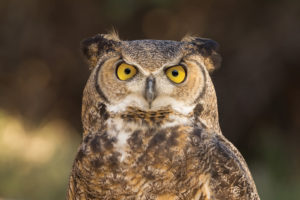 Great Horned Owl
Great Horned Owl
Bubo virginianus
A large, bulky owl with prominent ear tufts, white throat, black-gray beak, and bright yellow eyes. Known as the “Tiger of the Sky” because of its keen hunting skills and ability to capture prey sometimes larger or heavier than the owl itself. Noticeable tall feather tufts—which look like horns or ears—angled on the top of their head (owl ears are actually on the side of the head). Distinctive, deep, booming hoots are one of the most recognizable owl calls.
SIZE 18-25 inches
WINGSPAN Up to 5 feet
WEIGHT 1.5 to 5.5 pounds
HABITAT Highly adaptable; can be found in a wide variety of habitats, including both coniferous and deciduous forests, swamp forests, mangroves, farmland, deserts, and even city parks
DIET Mostly small mammals such as hares, ground squirrels, and voles; also preys on birds, amphibians, reptiles, fish, and insects, and even smaller owls
NESTING Most commonly abandoned nests of Red-tailed Hawk and other birds or squirrels, but also tree cavities, cactus, haylofts, cliffs, and caves
HUNTING HABITS Opportunistic but primarily a nocturnal perch hunter. Often hunts along forest edges and meadows
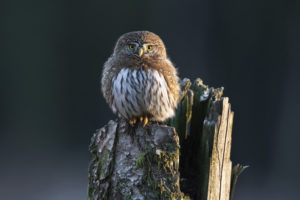 Northern Pygmy Owl
Northern Pygmy Owl
Glaucidium gnoma
A plump little owl with short wings and long tail; yellow eyes, yellowish-white beak, and grayish-brown feathers with fine white spotting. This tiny owl is one of the smallest in North America, but is a fierce little predator that frequently preys on birds and mammals larger than itself. Pygmy Owls literally have “eyes on the back of their heads”, or so it seems—the backs of their heads are feathered with a pair of quite convincing “eye spots” that are just variations in feather coloring. Researchers believe that they confuse both predators and songbirds that might mob them.
SIZE 6 to 7 inches
WINGSPAN 15 inches
WEIGHT 2 to 2.5 ounces
HABITAT Mostly coniferous and deciduous forest edges
DIET Main foods include small to medium sized birds, such as waxwings and chickadees; mice, voles, shrews; sometimes insects, reptiles and amphibians
NESTING Cavity nester; nests in holes made by woodpeckers
HUNTING HABITS Diurnal (hunts during daylight) but also crepuscular (dawn and dusk). Primarily a perch and pounce hunter but known to raid nests
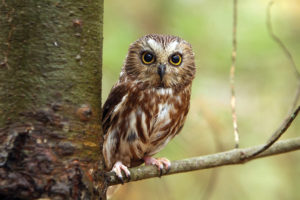 Northern Saw-Whet Owl
Northern Saw-Whet Owl
Aegolius acadicus
A small reddish-brown owl with a large, round head, yellow eyes, black beak, and feathered feet. Warm brown body feathers with white spots on nape; belly is white with reddish streaks. In 2020, a Northern Saw-Whet Owl was found at the base of the Rockefeller Center Christmas Tree. Named “Rocky” the Owl, she was later transported back to upstate New York to better habitat. It is still not known if this charming female saw-whet was hiding in the tree during the entire transport or if she was migrating above New York City and took shelter in the dense foliage later.
SIZE 6 to 8-1/2 inches
WINGSPAN 18 to 22 inches
WEIGHT 2.5 to 3.5 ounces
HABITAT Mostly coniferous forests; sometimes wooded riparian areas, swamps, and bogs
DIET Mostly deer mice and voles: sometimes small birds and insects
NESTING Cavity nester; nests in holes made by woodpeckers or nest boxes
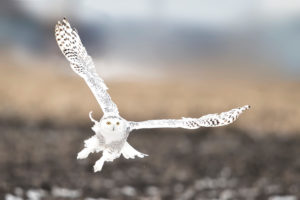 Snowy Owl
Snowy Owl
Bubo scandiacus
Large, white owl with bright yellow eyes, a dark beak, and thickly feathered feet. Adult males are pure white and females are white with dark bars or spots. One of the few species of owl that builds its own nest. It takes several years for males to turn totally white. Hedwig, Harry Potter’s friend, companion, letter carrier and protector, was a Snowy Owl. Considered nomadic, these hardy hunters travel many miles in search of their favorite foods.
SIZE 21 to 28 inches
WINGSPAN 4/12 feet
WEIGHT 1-1/2 to 6-1/2 pounds
HABITAT Tundra, meadows, marshes, dunes; during nesting season, lives on tundra
DIET Mostly lemmings, voles, and other rodents; often birds, sometimes rabbits and other small mammals
NESTING On the ground, atop low mounds in the Arctic tundra
HUNTING HABITS Mostly diurnal, but will hunt any time of day in the constant daylight of Arctic summer
 Western Screech Owl
Western Screech Owl
Megascops kennicotti
A small, grayish owl with yellow eyes, dark beak, and small ear tufts, with white wing bars and white shoulder streaks. Screech Owls are among the most common owls in the United States, but you might not see them—their gray-brown coloration and wide streaking allows them to blend in perfectly with the bark of trees.
SIZE 8 to 9 inches
WINGSPAN 20 inches
WEIGHT 4 to 9 ounces
HABITAT Mostly riparian areas; also forests and deserts
DIET Variety of small animals including: insects, reptiles, amphibians, crayfish, small mammals, small birds
NESTING Cavity nester, often in holes made by Flickers; will use nest boxes
HUNTING HABITS Nocturnal, begins shortly after sunset; sits and waits for prey, will also forage on the ground


